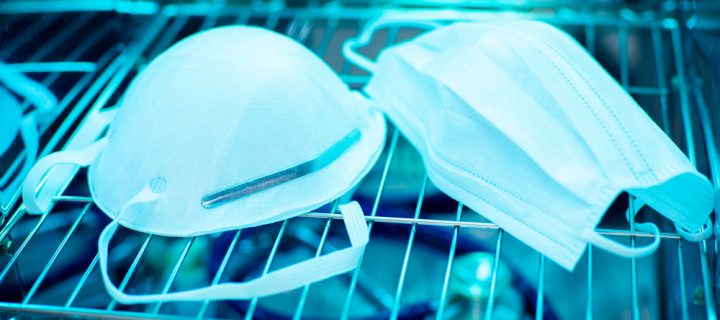With the right dose at the proper distance and angle, researchers from Henry Ford Health System say decontamination can be achieved.
If you actually have an N-95 mask in your possession, you might count yourself as lucky. In essence, an N95 face mask is a type of respirator that does a really good job. These masks block about 95% of very small particles that can spread the novel coronavirus, hence their name. Some N95 masks have a one-way valve on them that releases unfiltered air when the wearer exhales. Because of this, they have been banned in some areas. Those without a valve, however, can really come in handy.
Related: Restaurants as a COVID-19 Hotspot
Of course, the Centers for Disease Control and Prevention does not advocate the general public use these masks during the pandemic. The masks are now considered to be critical supplies needed by health care workers and first responders on the front lines. But you may have already had a stash of these masks before the pandemic hit. You may have had them for other occupations. Regardless of your situation, if you are running low on supplies, the results of a new study may be welcome news.
N95 masks are generally made to be disposed of. A recent study is proving you can reuse them if sanitized properly, however.
Better for Some Models
Researchers from Henry Ford Health System and the University of Michigan showed that N95 masks contaminated by COVID-19 can be safely “cleaned” and sanitized using ultraviolet C (UV-C) light.
With the help of a phototherapy unit emitting a high dosage, it was possible to sanitize the mask in under two minutes. The structural integrity of the mask was kept intact, as was overall fit. This process was found to work best on face pieces from models 3M 1860 and Moldex 1511.
Related: COVID-19 and Indoor Playgrounds
It also worked well on straps from models 3M 8210 and Moldex 1511. Researchers warned that with some models, the UVC treatment degraded the straps, but not on all. It could be advisable to wipe your straps with ethanol before subjecting your mask to UVC light decontamination for extra disinfection. And users must re-fit their mask after every disinfection.
Researchers are excited by their results.
“Our findings reveal a practical, and viable option should hospitals encounter shortages of N95s in the future,” says the study’s lead author David Ozog, M.D. Ozog is chair of Henry Ford’s Department of Dermatology in Detroit. “Using UV-C has been shown to be effective in killing other coronaviruses and the flu virus. We were able to replicate that sterilization effectiveness with COVID-19,” he added.
Distance and Curvature
In order to ensure the decontamination process is effective, a formula for UV-C dose was developed by Indermeet Kohli, Ph.D, a dermatology physicist at Henry Ford. Both the exterior and interior surfaces of the mask need proper coverage. The distance between the facemask and the lamps, as well as the curvature of the mask are also important for attaining the right amount of exposure. If not done properly, front-line workers could be in dire danger.
According to Ozog, your best bet is to always use a new N95 mask. Sterilization by UV-C light should only be done when the masks are in very short supply.
For more on this study, and its details, click here.
photo credits: Nor Gal/Shutterstock.com












